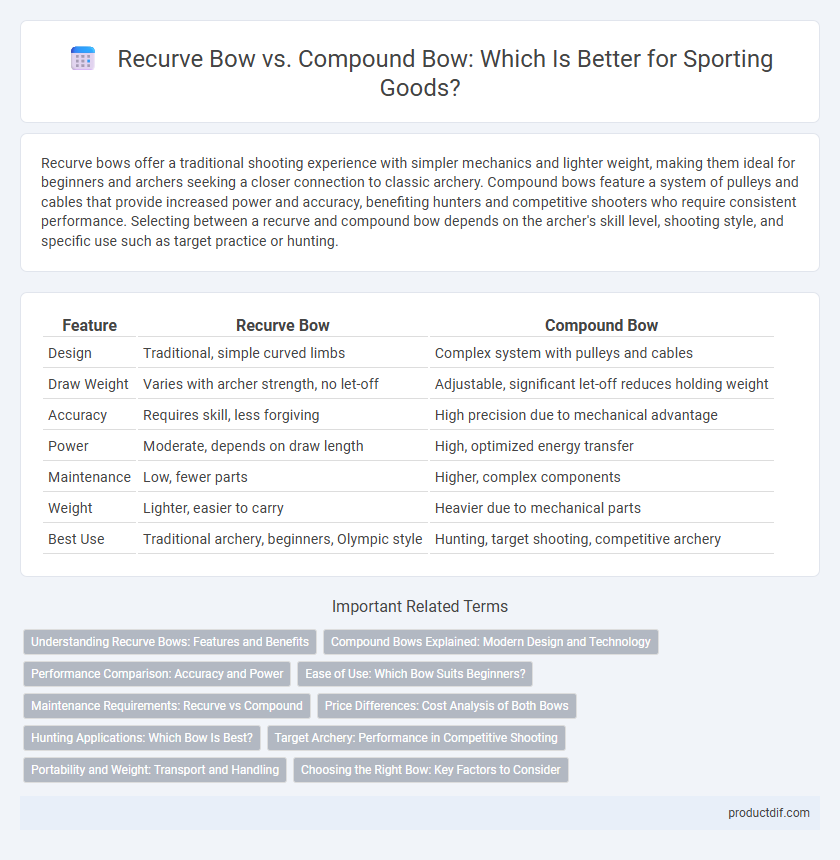Recurve bows offer a traditional shooting experience with simpler mechanics and lighter weight, making them ideal for beginners and archers seeking a closer connection to classic archery. Compound bows feature a system of pulleys and cables that provide increased power and accuracy, benefiting hunters and competitive shooters who require consistent performance. Selecting between a recurve and compound bow depends on the archer's skill level, shooting style, and specific use such as target practice or hunting.
Table of Comparison
| Feature | Recurve Bow | Compound Bow |
|---|---|---|
| Design | Traditional, simple curved limbs | Complex system with pulleys and cables |
| Draw Weight | Varies with archer strength, no let-off | Adjustable, significant let-off reduces holding weight |
| Accuracy | Requires skill, less forgiving | High precision due to mechanical advantage |
| Power | Moderate, depends on draw length | High, optimized energy transfer |
| Maintenance | Low, fewer parts | Higher, complex components |
| Weight | Lighter, easier to carry | Heavier due to mechanical parts |
| Best Use | Traditional archery, beginners, Olympic style | Hunting, target shooting, competitive archery |
Understanding Recurve Bows: Features and Benefits
Recurve bows feature limbs that curve away from the archer when unstrung, providing increased power and smooth energy transfer for precise shooting. Their simple design makes them lightweight, easier to maintain, and ideal for traditional archery and beginners seeking better form development. The lack of mechanical components results in a quieter shot, enhancing stealth in hunting and a more natural shooting experience.
Compound Bows Explained: Modern Design and Technology
Compound bows utilize a system of cams and pulleys that reduce holding weight and increase arrow speed, offering superior accuracy and power compared to traditional bows. The modern design incorporates advanced materials such as carbon fiber and aluminum alloy, enhancing durability while maintaining lightweight properties. Technological innovations like adjustable draw weights and let-off percentages provide shooters with customizable performance tailored to various archery disciplines.
Performance Comparison: Accuracy and Power
Recurve bows offer a traditional shooting experience with moderate power and accuracy, relying heavily on the archer's skill and form. Compound bows use a system of pulleys and cams to increase arrow speed and maintain consistent accuracy, delivering higher power and precision for target shooting and hunting. Performance comparisons show compound bows excel in accuracy and power due to mechanical advantages, while recurve bows provide greater flexibility and simplicity for experienced archers.
Ease of Use: Which Bow Suits Beginners?
Recurve bows are generally easier for beginners due to their simple design, lighter weight, and straightforward maintenance, allowing new archers to focus on building proper form and technique. Compound bows feature a system of pulleys and cams that provide a let-off, reducing holding weight at full draw but require more complex tuning and adjustment, making them less intuitive for novices. Therefore, recurve bows typically suit beginners better by offering a more accessible and less technical introduction to archery.
Maintenance Requirements: Recurve vs Compound
Recurve bows require regular string waxing and careful inspection for limb damage to maintain optimal performance, while compound bows demand more intricate upkeep, including cam and cable adjustments and lubrication to ensure mechanical efficiency. The complex pulley system of compound bows makes maintenance more technical, often necessitating professional tuning, whereas recurve bows offer simpler upkeep ideal for beginners. Proper maintenance of either bow type prolongs lifespan and preserves accuracy, with compound bows typically requiring more frequent and detailed servicing.
Price Differences: Cost Analysis of Both Bows
Recurve bows generally cost between $100 and $600, making them a more affordable option for beginners and casual archers. Compound bows, equipped with advanced cam systems and materials, often range from $300 to over $1,500, reflecting higher manufacturing complexity and performance features. The price gap results from technology integration, with compound bows offering better accuracy and power at a premium cost.
Hunting Applications: Which Bow Is Best?
Recurve bows offer simplicity and a traditional shooting experience favored for close-range hunting due to their light weight and ease of maintenance. Compound bows provide superior accuracy and power with their pulley system, making them ideal for longer-range hunting and targeting larger game. Hunters seeking versatility and enhanced precision often prefer compound bows, while those valuing stealth and traditional skill tend to choose recurve bows.
Target Archery: Performance in Competitive Shooting
Recurve bows offer precision and traditional shooting experience favored in Olympic target archery, with consistent accuracy over varied distances. Compound bows provide adjustable draw weights and let-off features, enhancing stability and shot consistency, often resulting in higher speed and tight groupings in competitive contexts. Performance in target archery depends on shooter preference, but compound bows generally deliver superior mechanical advantage for enhanced aiming and power.
Portability and Weight: Transport and Handling
Recurve bows are generally lighter and more compact, enhancing portability for outdoor activities and easier transport during hiking or hunting trips. Compound bows, while heavier due to cables and pulleys, offer superior handling stability but may require specialized cases for safe transportation. Lightweight materials like carbon fiber in recurve bows further improve ease of carrying without compromising durability.
Choosing the Right Bow: Key Factors to Consider
When choosing between a recurve bow and a compound bow, consider factors such as shooting purpose, ease of use, and maintenance requirements. Recurve bows offer simplicity, lighter weight, and a more traditional shooting experience ideal for beginners and traditional archers, while compound bows provide increased accuracy, power, and let-off benefits suited for hunting and competitive shooting. Bow weight, draw length, budget, and personal comfort also play crucial roles in selecting the optimal bow for sporting success.
Recurve Bow vs Compound Bow Infographic

 productdif.com
productdif.com